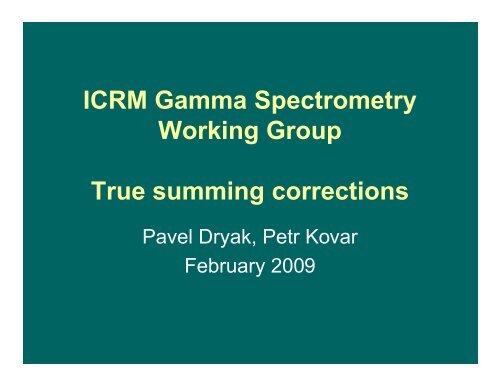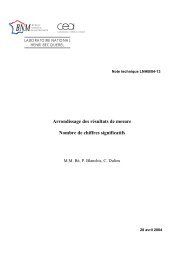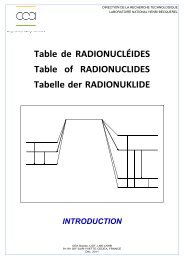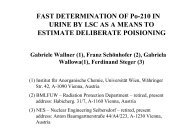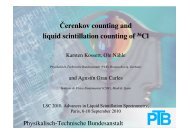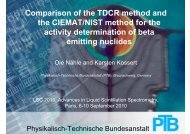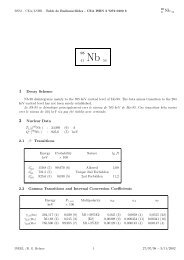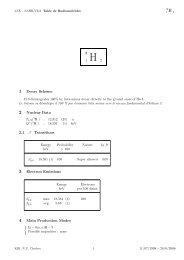ICRM Gamma Spectrometry Working Group True summing ... - LNHB
ICRM Gamma Spectrometry Working Group True summing ... - LNHB
ICRM Gamma Spectrometry Working Group True summing ... - LNHB
Create successful ePaper yourself
Turn your PDF publications into a flip-book with our unique Google optimized e-Paper software.
<strong>ICRM</strong> <strong>Gamma</strong> <strong>Spectrometry</strong><br />
<strong>Working</strong> <strong>Group</strong><br />
<strong>True</strong> <strong>summing</strong> corrections<br />
Pavel Dryak, Petr Kovar<br />
February 2009
Introduction<br />
Summation effects play an important role in<br />
measurement of activity of radionuclides with a complex<br />
decay scheme by means of a spectrometric method. If<br />
simultaneous emission of photons occurs, areas of<br />
peaks must be corrected. In order to calculate the<br />
correction, we need to know the probability of the<br />
simultaneous emission of other gamma photons, x-ray<br />
and particles.<br />
Coincidence probabilities were determined using the<br />
Monte Carlo method by CMI codes.<br />
Values of total and peak efficiencies were calculated<br />
using MCNP code. A model of the detector (GMX15-<br />
PLUS-S), shielding and <strong>LNHB</strong> source was created.
Coincidence probabilities computation<br />
The process of the radionuclide decay is simulated by<br />
the program based on the Monte Carlo method. Every<br />
history starts by alpha, electron, positron or EC decay to<br />
some level of the daughter nuclei according to decay<br />
intensities then goes on step by step by gamma<br />
transition or internal conversion to lower and lower levels<br />
up to the ground-state. The emission of gamma photons,<br />
beta, x-rays from EC decay or internal conversion is<br />
generated in single decay. Every photon in the one<br />
decay is recorded and accumulated together with its<br />
mutual coincidence and <strong>summing</strong> with other gamma, KX,<br />
LX, annihilation photons, beta particles.<br />
The history is repeated many times.
Definitions, relations<br />
The correction relations are as follows:<br />
A corrected=A exp / K<br />
K= K Kdec* dec* Kg amma * K sumin<br />
Kdec denotes the <strong>summing</strong>-out effect with β or<br />
X-rays (from EC) emitted at the decay<br />
K gamma denotes the <strong>summing</strong>-out effect with<br />
other gamma and X-ray from internal conversion<br />
K sumin denotes the <strong>summing</strong>-in effect
Equations for K dec<br />
K dec for beta decay:<br />
Individual contribution of any beta component<br />
to <strong>summing</strong>-out effect equals<br />
pGB*T(E bmax)<br />
pGB: coinc. probability of γ photon with the β component<br />
T(Ebmax): total efficiency for β component with Ebmax Peak area is lowered by the sum of all individual<br />
contributions, because any component is in parallel<br />
cascades with photon, thus:<br />
K dec = 1-Σ(pGB*T(E bmax)).
K dec for electron capture (EC)<br />
Determination of K dec for electron capture (EC) decay is<br />
more complicated.<br />
The gamma photon is preceded by parallel cascade of<br />
the Kα ,Kβ, LX-ray from direct capture and LX-ray emitted<br />
after Auger effect supplying K α emission. (Any<br />
contribution of Auger electrons is neglected).<br />
K α and LX-ray are in a direct cascade. It is compensated<br />
by the term<br />
pGK α*TK α*pLkask*TL<br />
in the next equation for individual contribution D:
D = pGK α*TK α*(1-pLkask*TL)+pGK β*TK β+pGL*TL+pLAug*TL+pLkask*TL<br />
where<br />
pGK α: coincidence probability of γ photon with K α X-ray from EC<br />
pGK β: coincidence probability of γ photon with K β X-ray from EC<br />
pGL: coincidence probability of γ photon with LX-ray from EC<br />
pLAug: coincidence probability of γ photon with LX-ray after Auger effect<br />
supplying K α emission<br />
pLkask: coincidence probability of γ photon with LX-ray after K α emission<br />
T denotes total efficiency, K α, K β,L represent an X-ray energy<br />
Net peak area is lowered by the sum of all individual contributions of decays<br />
to all levels, because any component is in a parallel cascade with photon,<br />
thus:<br />
Kdec = 1-ΣD
Equations for K gamma<br />
Summing-out effect due to coincidence with other γ photons, energy E1.<br />
Again, there is necessary to determine individual contribution D of all<br />
coincidence gamma photons.<br />
The equation is very similar to previous equation, the term pGG*TE1 is<br />
added.<br />
D = pGG*TE1+pGK α*TK α*(1-pLkask*TL)+pGK β*TK β+pGL*TL+pLAug*TL+pLkask*TL<br />
pGG: coinc. prob. of γ photon with gamma photon of energy E1<br />
pGK α: coinc. prob. of γ photon with K α X-ray from internal conversion<br />
pGK β: coinc. prob. of γ photon with K β X-ray from internal conversion<br />
pGL: coinc. prob. of γ photon with Lx-ray from internal conversion<br />
pLAug: coinc. prob. of γ photon with LX-ray after Auger effect supplying K α emission<br />
pLkask: coinc. prob. of gamma photon with LX-ray after K α emission<br />
T : total efficiency, E1, K α, K β, L represent γ or X-ray photon energy
Equations for γ photons with energy E0 should be<br />
created individually.<br />
The general form of K gamma(E0) for several<br />
photons (energies E1, E2, E3, …) in direct cascade is:<br />
K gamma(E0) = (1- D(E1))*(1 – D(E2))*(1 – D(E3))* …<br />
Technique can be called “multiplying“<br />
The general form of K gamma(E0) for several photons<br />
(energies E4, E5, …) in parallel cascade is:<br />
K gamma(E0) = (1- D(E4)-D(E5) - … )<br />
Technique can be called “adding“
Both techniques should be combined in case coincident<br />
parallel and direct cascades.<br />
Example for 604 keV ( 134 Cs):<br />
K gamma(604)= (1-D(563)-D(796)-D(1039)-D(1365))*(1-D(475)-D(243)-D(802)-D(569)-D(327))<br />
Technique can be called “realistic“<br />
All equations for all photons are in tables hereinafter, pages<br />
from 18 to 20.
Equations for K sumin<br />
Summing-in effect to photon of energy E0 due to cross-over cascade of<br />
photons of energies E1 and E2 (E0 = E1 + E2) is expressed by the factor<br />
K sumin after equation:<br />
K sumin(E0)=(1+Ps(E1,E2)*ε(E1)* ε (E2)/ ε (E0) )<br />
Ps(E1,E2): <strong>summing</strong> probability of photon energies E1 and E2 to E0<br />
ε (E1), ε (E2) and ε (E0): peak efficiencies for photon of energies E1, E2<br />
and E0<br />
As many cascades Ea→Eb are <strong>summing</strong> to energy E0, as many terms<br />
Ps*ε (E1)*ε (E2)/ε (E0) in equation must be used. The values of the Ps<br />
are different for each cascade.<br />
K sumin(E0) = (1 + ΣPs(Ea,Eb)* ε (Ea)* ε (Eb)/ ε (E0))
Detector model for MCNP calculations<br />
A special model was created for <strong>ICRM</strong><br />
comparison. Construction information of the<br />
Detector GMXI5-PLUS-3, detector shielding,<br />
support and source were provided by <strong>LNHB</strong>.<br />
The model is illustrated in the<br />
pictures.<br />
Detector model was used for peak and total<br />
efficiencies beta, gamma and x-ray of all<br />
three geometries.
Total and peak efficiencies<br />
Corrected experimental peak eff. values and calculated MCNP-values<br />
for geometry “2cm” are presented in following pictures.<br />
Eu-152, black: calculated; blue: exp uncorrected; pink: exp corrected<br />
eta peak<br />
0,100000<br />
0,010000<br />
0,001000<br />
2 cm Eu<br />
0 200 400 600 800 1000 1200 1400 1600<br />
keV
Cs-134 , peak eff.: black: calculated; blue: exp uncorrected; pink: exp corrected<br />
eta peak<br />
1<br />
0,1<br />
0,01<br />
0,001<br />
Cs-134 2 cm<br />
1 10 100 1000 10000<br />
keV
Some low energy experimental points were added to the<br />
previous picture for 134 Cs:<br />
6.5 keV (from sum peaks of Co-57),<br />
14.3 keV (from sum peaks of Y-88),<br />
22 keV (KX Cd-109),<br />
33.3 keV (from sum peaks of Ce-139),<br />
59.6 keV (Am-241),<br />
88 keV (Cd-109)
Total efficiencies for photons were calculated for geometries "2 cm", "5 cm" and "10 cm".<br />
Green: “10 cm” with several experimental values (125; 661; 834 and 1250 keV)<br />
Pink: “5 cm”<br />
Blue: “2 cm”<br />
0,140<br />
0,120<br />
0,100<br />
0,080<br />
0,060<br />
0,040<br />
0,020<br />
0,000<br />
1 10 100 1000 10000
List of K gamma equations .<br />
There were only strong parallel cascade taken into<br />
account. All remaining coincidence photons not explicitly<br />
mentioned in the equation are considered as direct<br />
cascade. They are include in the term π(1-Drest) as the<br />
product of individual contributions (1-D).
EuSm 121.78 (1-D(244)-D(688)-D(841)-D(919)-D(964)-D(1112)-D(1249)-D(1408)-<br />
D(1457)-D(1528))*π(1-Drest)<br />
EuSm 244.7 (1-D(121)*(1-D(444)-D(656)-D(674)-D(719)-D(867)-D(926)-D(1005)-<br />
D(1212))* π(1-Drest)<br />
EuSm 688.67 product of all (1-D)<br />
EuSm 443.969 product of all (1-D)<br />
EuSm 1085.85 (1-D(444)-D(564))* π(1-Drest)<br />
EuSm 964.07 (1-D(444)-D(564))* π(1-Drest)<br />
EuSm 1112.09 product of all (1-D)<br />
EuSm 867.38 product of all (1-D)<br />
EuSm 1408.03 (1-D(121))*(1-D(239))<br />
EuSm 443.957 (1-D(121))*(1-D(239))*(1-D(964)-D(1085))*(1-D(239))* π(1-Drest)<br />
EuSm 1212.88 product of all (1-D)<br />
EuSm 564,06 (1-D(1085)-D(964)-D(719))* π(1-Drest)
EuGd 344,28 (1-D(271)-D(411)-D(586)-D(765)-D(779)-D(1089)-D(1299)* π(1-Drest)<br />
EuGd 411,12 (1-D(344))*(1-D(368)-D(527)-D(678)-D(794)-D(937))* π(1-Drest)<br />
EuGd 778.9 (1-D(344))*(1-D(482)-D(520))<br />
EuGd 1089.74 (1-D(344))*(1-D(209))<br />
EuGd 1299,11 (1-D(344))
Cs-134 604.69 (1-D(563)-D(796)-D(1039)-D(1365))*(1-D(475)-D(243)-D(802)-D(569)-D(327))<br />
Cs-134 1167,92 (1-D(475)-D(802))*(1-D(327))<br />
Cs-134 563.23 (1-D(604))*(1-D(475)-D(802))*(1-D(327))<br />
Cs-134 795.84 (1-D(604))*(1-D(243)-D(569))*(1-D(327))<br />
Cs-134 1038.55 (1-D(604))*(1-D(327))<br />
Cs-134 475.32 (1-D(604))*(1-D(1168)-D(563))*(1-D(327))<br />
Cs-134 242.71 (1-D(604))*(1-D(796))*(1-D(327))<br />
Cs-134 1365.16 (1-D(604))<br />
Cs-134 801.93 (1-D(604))*(1-D(1168)-D(563))<br />
Cs-134 569.32 (1-D(604))*(1-D(796))<br />
Cs-134 326.61 (1-D(604))*(1-D(1168))*(1-D(563))*(1-D(796))*(1-D(1039)-D(475)-D(243))
Are equations for K gamma correct?
Test of K gamma equations correctness<br />
The difference among three computation<br />
techniques (adding, realistic and multiplying) is<br />
small for detection system with total efficiencies<br />
up to 12 %.<br />
The difference is notable if different three<br />
The difference is notable if different three<br />
methods are applied to a hypothetical detection<br />
system with total efficiency for photons (γ, X-ray)<br />
equal 1 and for Auger and conversion electrons<br />
0. Well-type Ge detector approaches such<br />
hypothetical detector type. The results for the<br />
three different methods are shown in the next<br />
tables.
Cs-134<br />
E0 adding realistic multiplying<br />
242,71 -1,0035 0,0000 0,0000<br />
326,71 -1,5019 0,00009 0,01121<br />
475,32 -0,8281 0,00018 0,02546<br />
563,23 -0,9946 0,00001 0,00013<br />
569,32 -0,9985 0,00000 0,00000<br />
604,69 -0,2433 0,00048 0,08618<br />
795,84 -0,1800 0,00083 0,00083<br />
801,93 -0,8227 0,00018 0,02566<br />
1038,55 -0,0042 0,00101 0,00101<br />
1167,92 0,00454 0,00529 0,1294<br />
1365,16 0,00092 0,00092 0,00092
EuGd<br />
E0 adding realistic multiplying<br />
344,28 0,2207 0,2779 0,3886<br />
411,12 -0,6050 0,0020 0,0025<br />
778,90 0,0013 0,0053 0,0053<br />
1089,74 0,0032 0,0055 0,0055<br />
1299,11 0,0053 0,0053 0,0053
EuSm<br />
E0 adding realistic multiplying<br />
121,78 -0,1519 0,0277 0,2721<br />
244,71 -0,7694 0,0179 0,0587<br />
443,96 -0,4948 0,0063 0,1255<br />
564,06 -0,4941 0,0015 0,1255<br />
688,67 0,0099 0,1591 0,1591<br />
867,38 -0,8218 0,0034 0,0034<br />
964,07 0,0548 0,0316 0,1658<br />
1085,85 0,8636 0,8643 0,8663<br />
1112,09 0,1590 0,1849 0,1849<br />
1212,88 -0,7889 0,0036 0,0036<br />
1408,03 0,1913 0,1916 0,1916
Comment:<br />
Adding method overestimates most of cases. Negative<br />
values have no physical meaning.<br />
Multiplying method is correct for direct cascades without<br />
paralel cascades. The correction is underestimated.<br />
Realistic method gives value Kgamma near zero, small<br />
positive correction corresponds to non-photon process<br />
(internal conversion at M,N,O levels, Auger emission not<br />
followed by photon emission).<br />
Photons 344, 688, 1085, 1112 and 1408 keV have high<br />
value of K gamma, because they are emitted in significant<br />
cases without coincidence with other photons.
Other results<br />
Total efficiencies for beta radiation were calculated using MCNP for geometries<br />
"2 cm", "5 cm" and "10 cm" . Efficiencies were calculated for real form of<br />
spectra, not only for Ebmax or mean beta energy.<br />
The values for all beta components of Eu-Gd are shown in the next picture.<br />
tot<br />
0,060<br />
0,050<br />
0,040<br />
0,030<br />
0,020<br />
0,010<br />
0,000<br />
EuGd, beta tot<br />
0 200 400 600 800 1000 1200 1400 1600<br />
Ebmax<br />
• Example of beta spectra in Eu – Gd decay with Ebmax=1474 keV<br />
N(E)<br />
0,02<br />
0,02<br />
0,02<br />
0,01<br />
0,01<br />
0,01<br />
0,01<br />
0,01<br />
0,00<br />
0,00<br />
0,00<br />
spectrum Ebmax 1474 keV<br />
0 0,2 0,4 0,6 0,8 1 1,2 1,4 1,6<br />
MeV
Example of positron spectra in Eu- Sm decay with Ebmax=730 keV<br />
0,035<br />
0,030<br />
0,025<br />
0,020<br />
0,015<br />
0,010<br />
0,005<br />
0,000<br />
EuSm poz 730 keV<br />
0 0,2 0,4 0,6 0,8<br />
MeV
Uncertainties<br />
Uncertainties type A of coincidence probabilities from Monte Carlo<br />
method are less than 0.0005 (k=1). They are lesser than uncertainties<br />
of photon intensities, conversion coefficients, branching ratios and<br />
other parameters coming into calculation.<br />
Uncertainties type B of Kgamma result from equations presented in the<br />
table 6 incorrectness.<br />
Parallelism or directness of weak cascades with intensity less than<br />
0.1% in Eu decay was omitted and all of them were suggested as<br />
direct.<br />
Equations for Cs-134 are exact.<br />
Equations for Kdec and Ksumin are exact.<br />
Estimation: Uncertainties of correction factors presented in the tables 7 and 8<br />
are on a level of uncertainties of main gamma photons and branching decay<br />
ratios.
Uncertainty “A” of the coincidence probabilities from Monte Carlo method are smaller than<br />
0,0005 (k=1) in all cases. They are less significant than uncertainties of intensities of photons,<br />
conversion coefficients, branching ratios and other parameters coming into calculation.<br />
One component of the Kgamma uncertainty “B” results from incorrectness of equations<br />
presented in table 6. Parallelism or directness of weak cascades with intensity less than 0,1% in<br />
Eu decay was omitted and all of them were suggested as direct.<br />
Equations for K gamma of 134 Cs are exact.<br />
Equations for K dec and K sumin are exact.<br />
Another component of the Kgamma uncertainty “B” results from calculated peak and total<br />
efficiencies.<br />
Peak efficiency: Deviations of calculated and experimental values of peak efficiency are smaller<br />
than 1 % for all geometries and main lines (see pictures in section 5).<br />
Total efficiency: the comparison experiment-calculation was performed only for geometry<br />
“10 cm”. Confidential experimental points ( 57 Co, 137 Cs, 54 Mn, 60 Co) vary from calculated values<br />
3 % at most. We suppose the maximum uncertainty of total efficiency 3 % for all geometries<br />
and typical uncertainty 1 % due to facts:<br />
The substantial part of total efficiency is a contribution of radiation scattered from surround<br />
materials. It is highest for geometry “10 cm”, for closer geometries is the contribution smaller.<br />
Deviations of calculated and experimental peak efficiency values are smaller than 1 % for all<br />
geometries, so the calculated total efficiencies have the same uncertainty.<br />
Estimation: uncertainty of all components (nuclear and atomic data, peak and total efficiencies<br />
etc.) propagates to the uncertainty of corrections factors presented in tables 7 and 8 on the<br />
level 0,004 (k=1).


